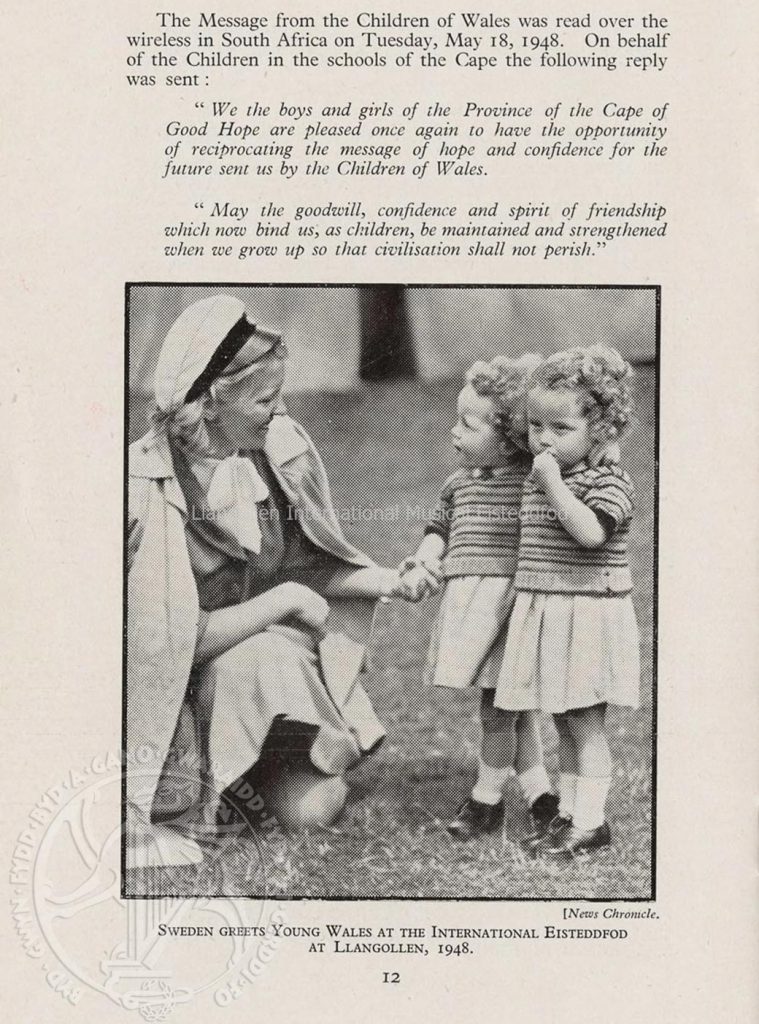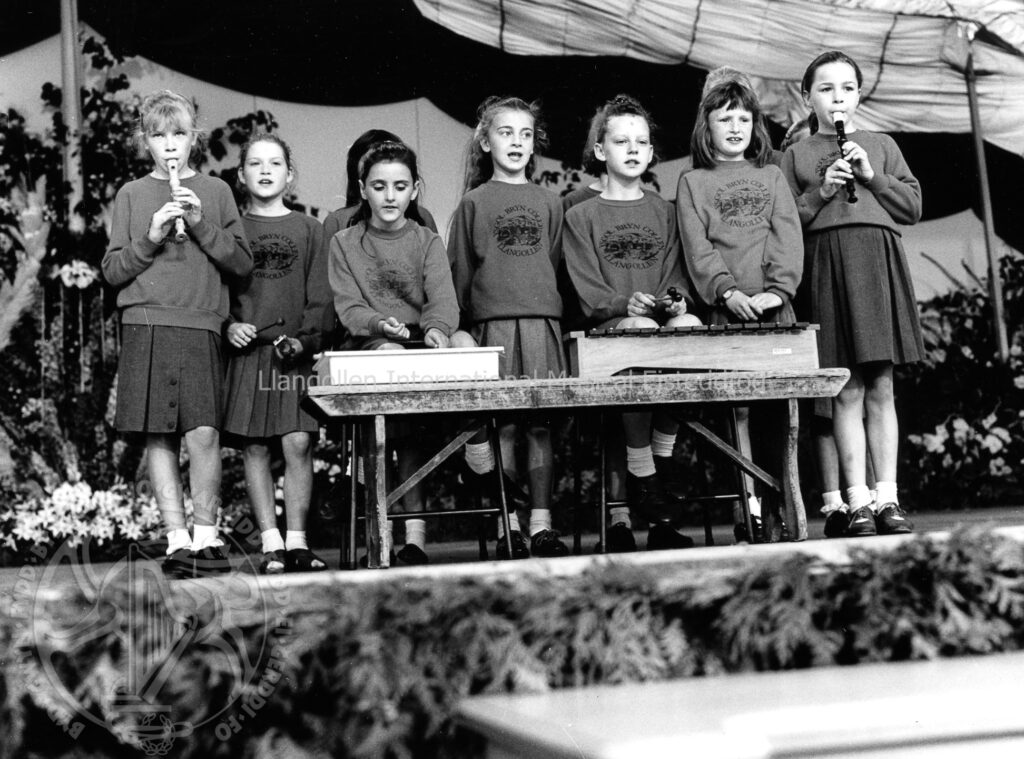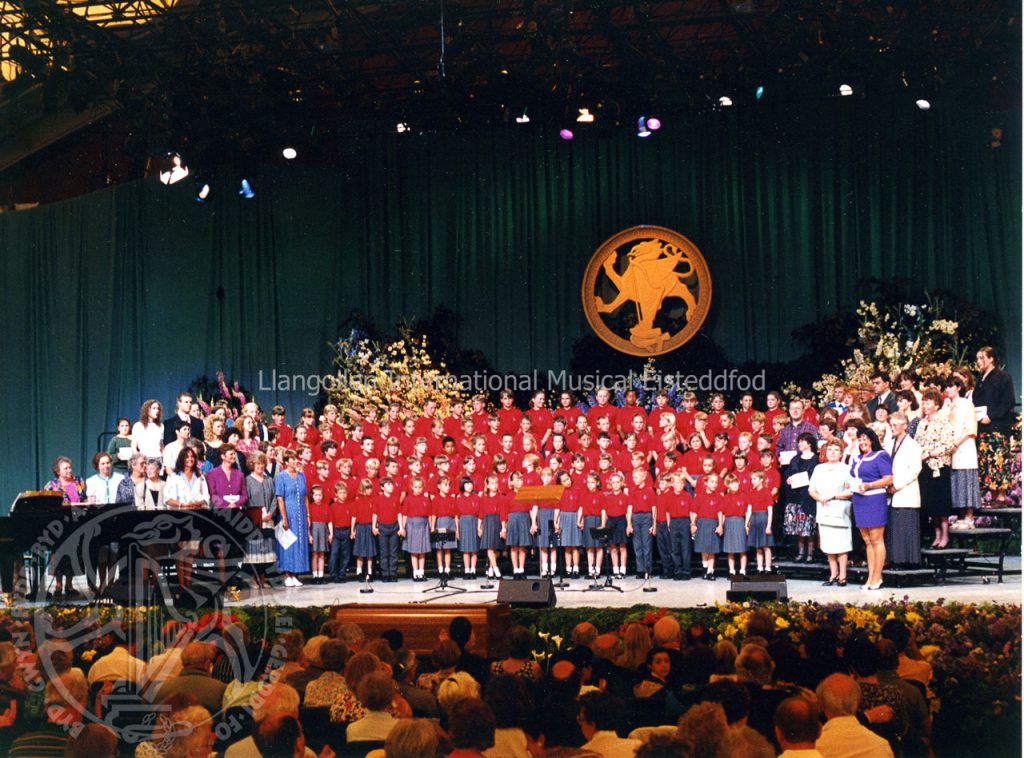The Llangollen Peace Message
That the children of Wales should and could send a message of peace and goodwill to the children of the world was the idea of Reverend Gwilym Davies, a noted Welsh pacifist. In the 1920s and 1930s he organised Welsh support for the League of Nations, and after WWII he helped found UNESCO and the Welsh United Nations Association. Rev Davies gave the first such message at the Urdd Eisteddfod in 1922, and it was first broadcast internationally by the BBC in 1924. A new text was written each year. Children’s organisations from many countries responded, up 50 in some years.

From 1949 local youngsters presented a peace message from the Llangollen Eisteddfod stage, an initiative of the chairman Jack Rhys Roberts. Urdd representatives had visited Llangollen during the 1947 and 1948 Eisteddfod weeks, and an image from Llangollen was used in the booklet produced by the Urdd to publicise the huge international response to its 1948 message. The initial intention was that Rev Davies himself would come to Llangollen to present the 1949 message, but his diary was too crowded. A happy chance.
So, the Eisteddfod hit on the idea that a single pupil of Dinas Brân School, usually a girl whose parents were prominent in the Eisteddfod organisation, would dress in Welsh costume and give the message in English and Welsh to the audience of 6000 or more packed into the marquee. Llangollen adopted and adapted the Urdd text each year; the presenter was thoroughly coached for the performance by the chairman’s wife Olwen, the French teacher at Dinas Brân School. Okay, it was effectively a retweet of the Urdd message, but in a much more dramatic and engaging setting.
The first presenter was Llinos Roberts, daughter of J Iorwerth Roberts from Publicity Committee. You can read the 1949 text here in Cymraeg and in English.
After 1983, a new policy was followed, with whole schools or groups of schools both devising the message and presenting it on stage; multimedia group formats with singing and drama became very popular, but there were also individual performances. The Welsh costumes mostly vanished. The new peace message has become the central vehicle by which the Eisteddfod promulgates its humanitarian message; it is repeated several times on Children’s Day.

In contrast to its current prominence, the annual presentation in Llangollen of a Children’s Message of Peace and Goodwill, to give its original full title, was not much fêted or publicised in its earliest years. It didn’t feature in the programme until the fourth message in 1952, and the press didn’t cover it at all. There was so much else going on to emphasise and deliver the Eisteddfod’s aim of promoting better international relations by bringing ordinary people together: practical things like welcoming 5000 competitors each year, accommodating them in people’s homes, and hosting their visits to the area; events like the ecumenical Christian services in Valle Crucis Abbey; singing, dancing and laughing together in Llangollen and in all the villages where competitors were put up; the uplifting presence of United Nations organisations; the press fascination with the human stories of the competitors; the symbolic words of the motto, taken round the world by the trophies given to winners. As the passage of years has reduced the extent to which these traditional methods of the Eisteddfod are both possible and newsworthy, the Children’s Peace Message has gained in relative strength. But its impact is local. A task for the future is to achieve a level of international recognition and response similar to that generated by the Urdd Peace Message.
During the 50th Eisteddfod in 1996 the people who had presented the Peace Message over the years were introduced and assembled on stage before that year’s Peace message was given by Bryn Collen School from Llangollen. Unfortunately the very earliest presenters weren’t traced and invited, because the organisers, relying on the erroneous programme information, believed that the first message was in 1952. The event was recorded on video; it was an emotional afternoon for all concerned.

© Chris Adams 2022





